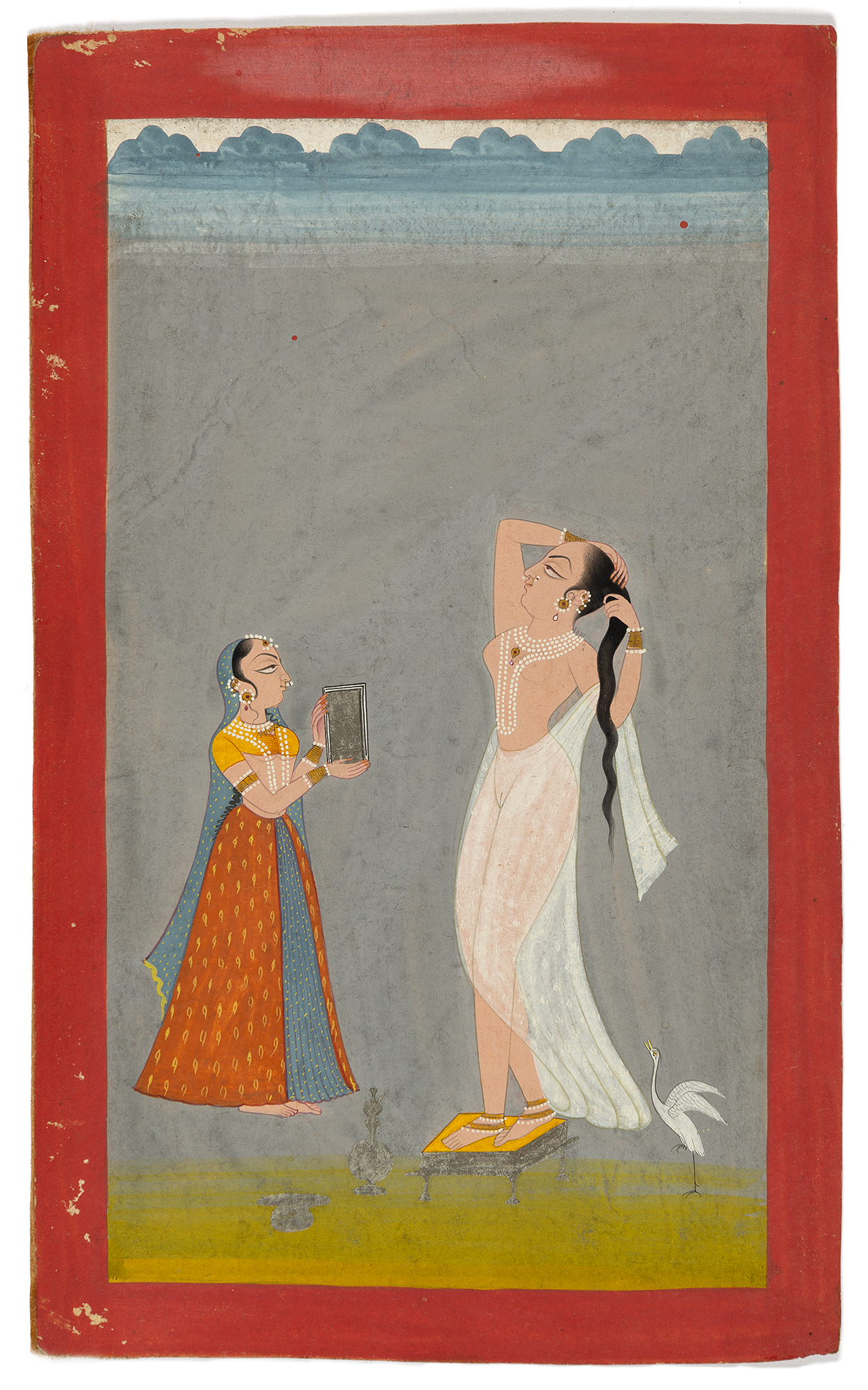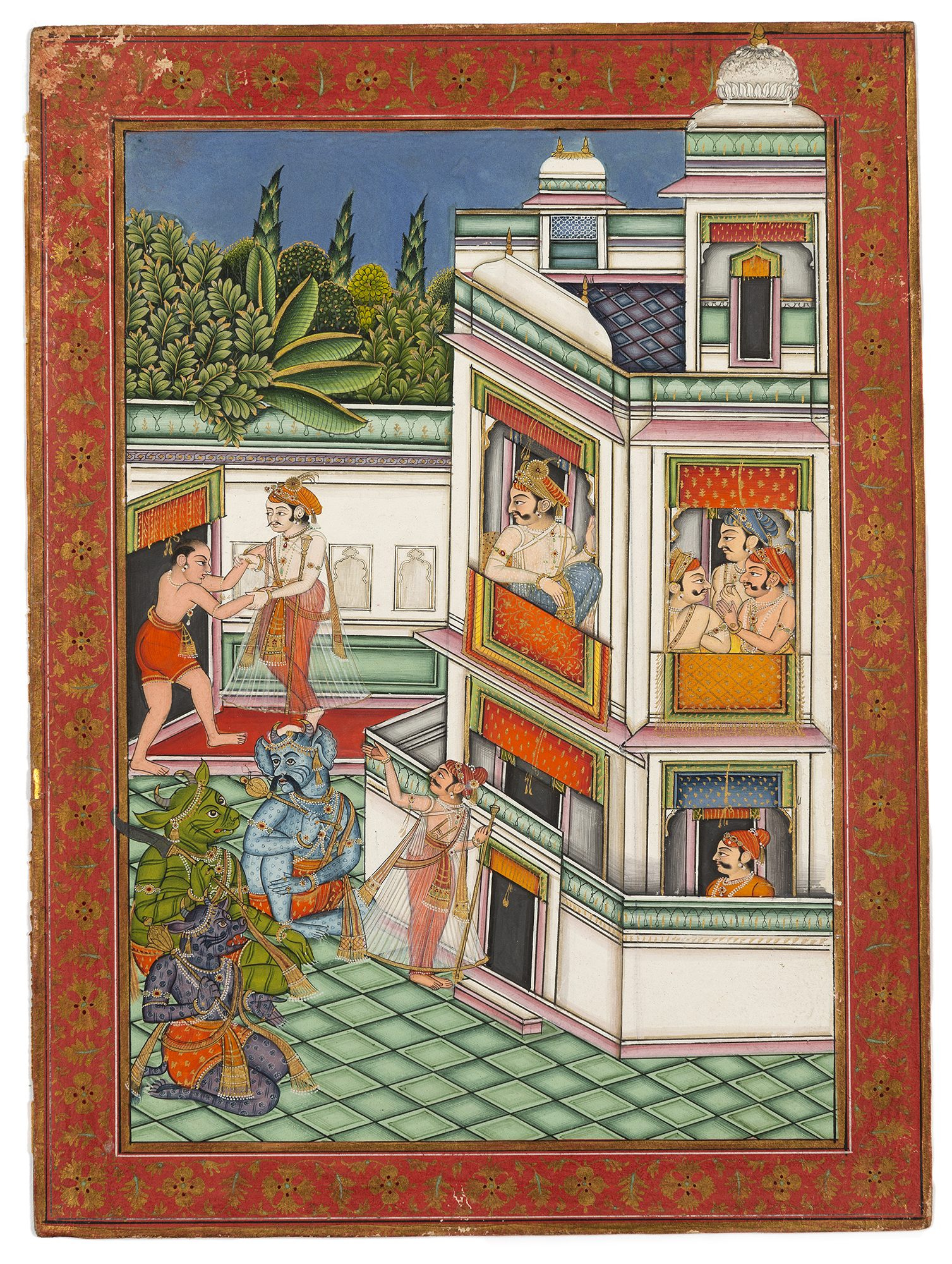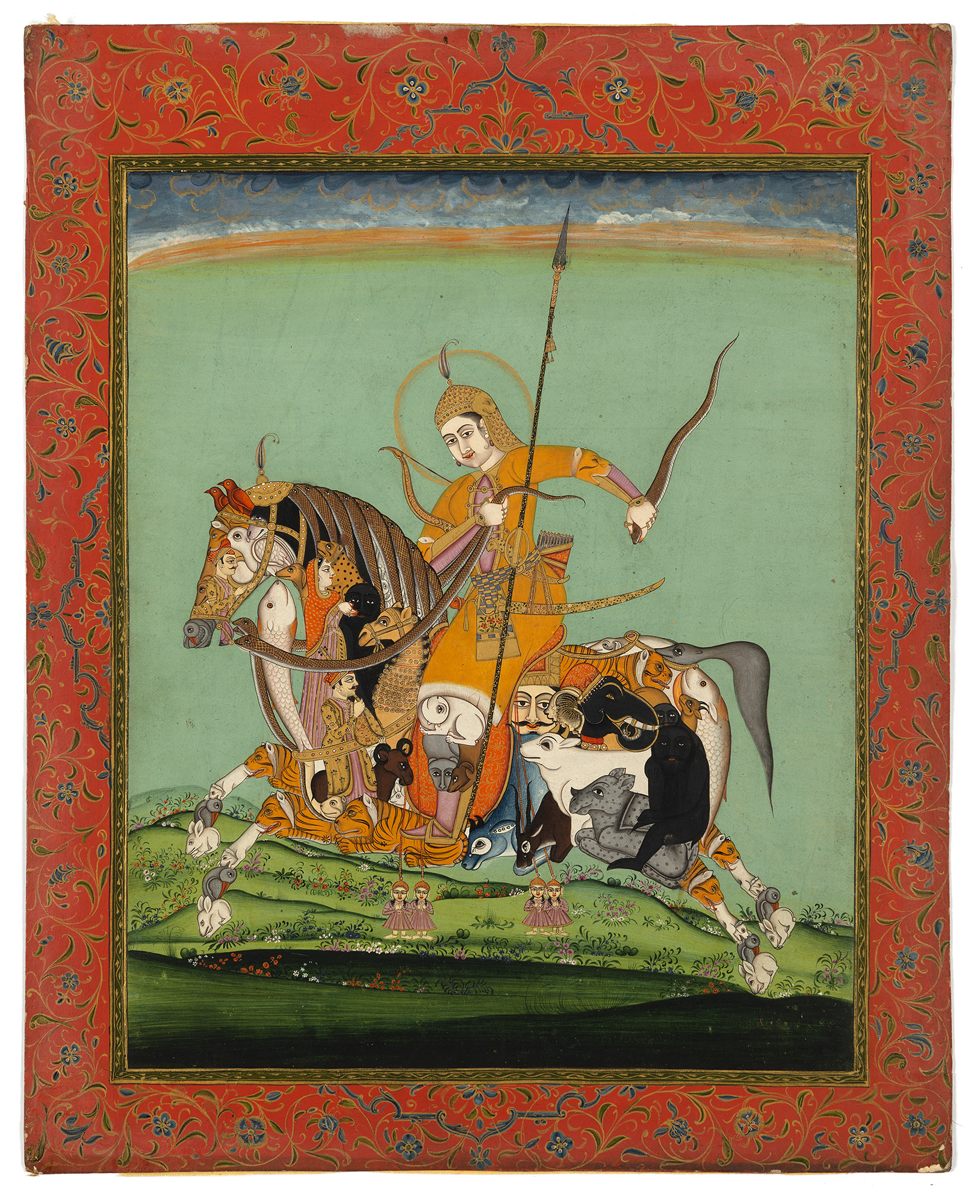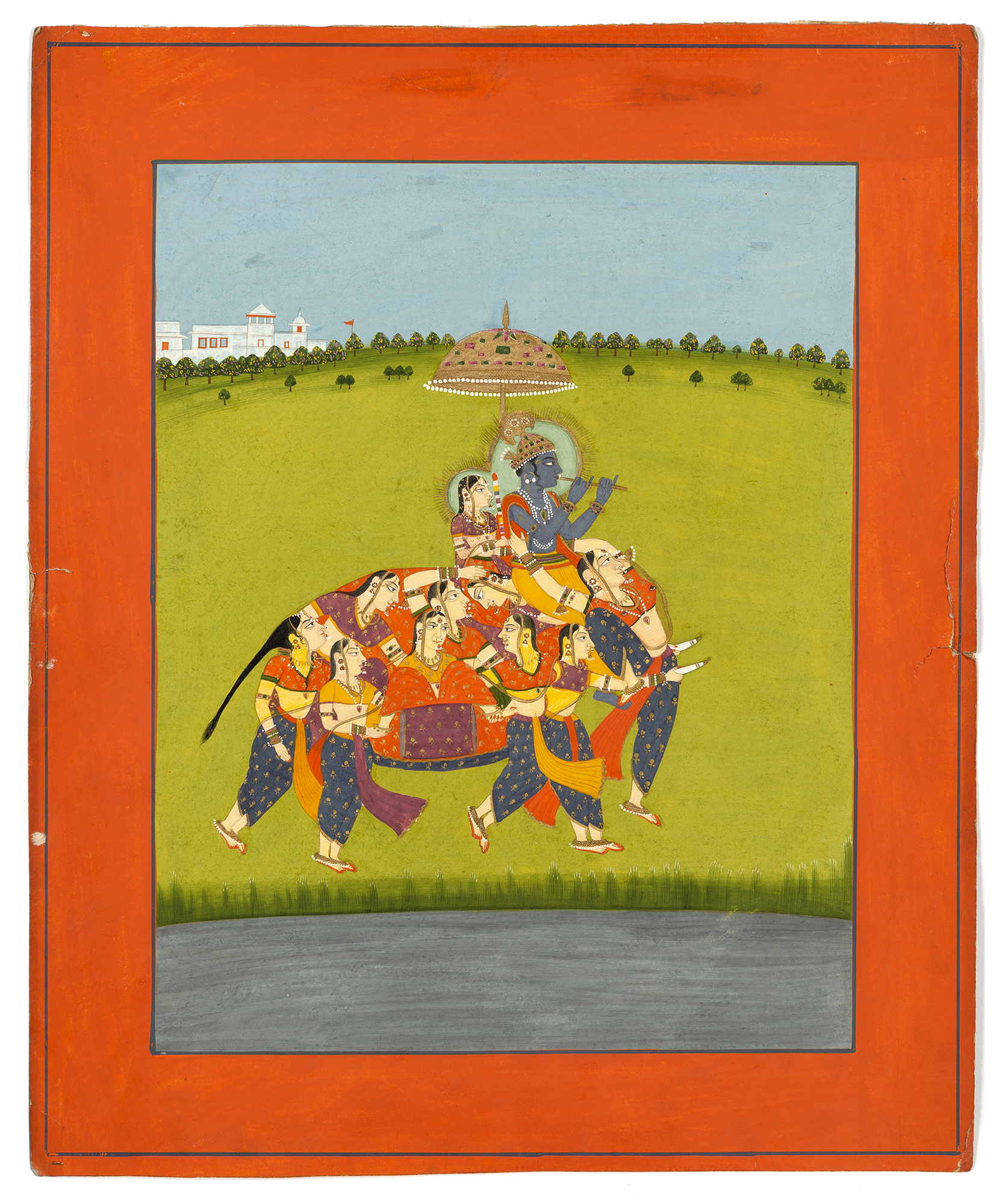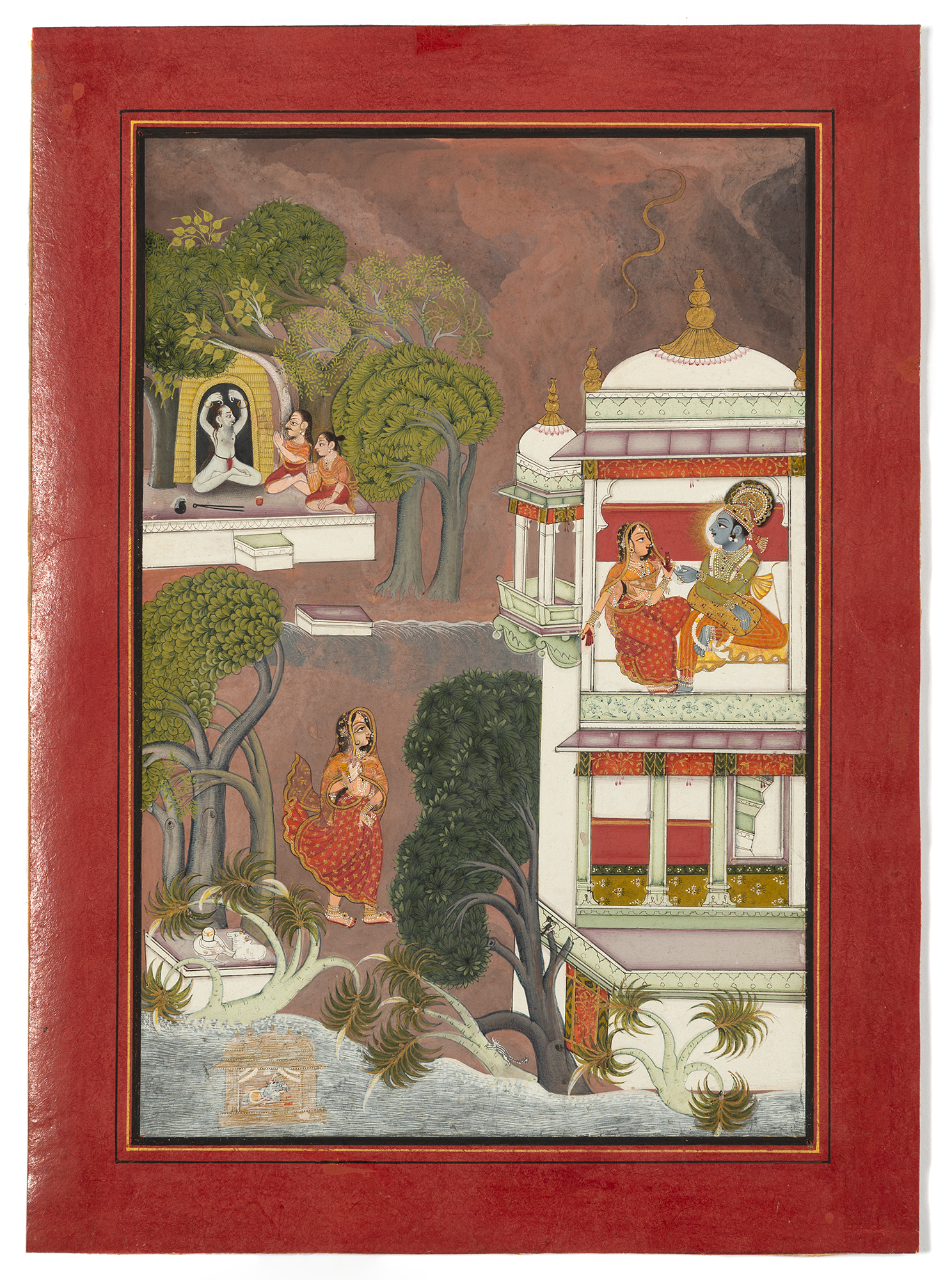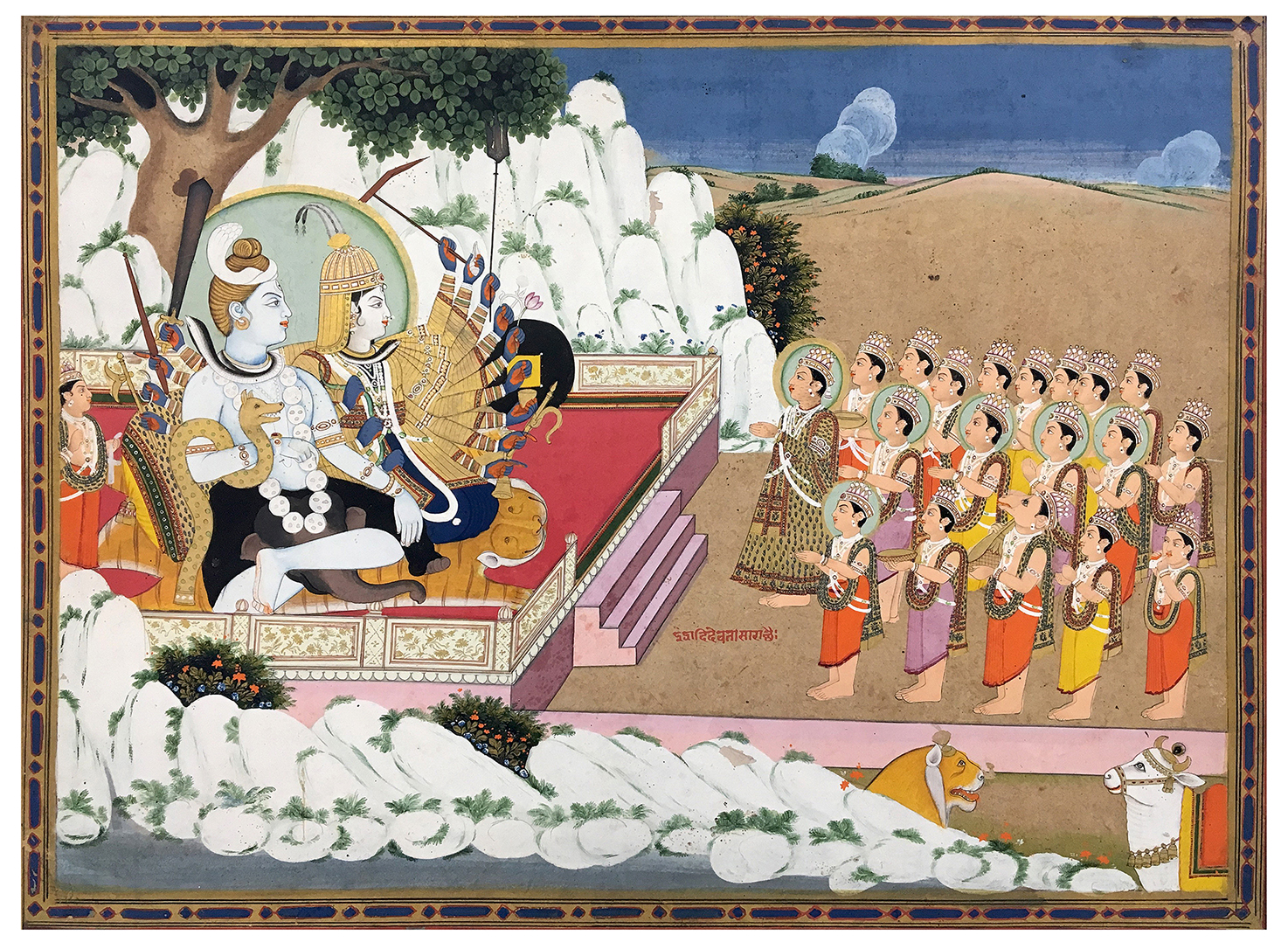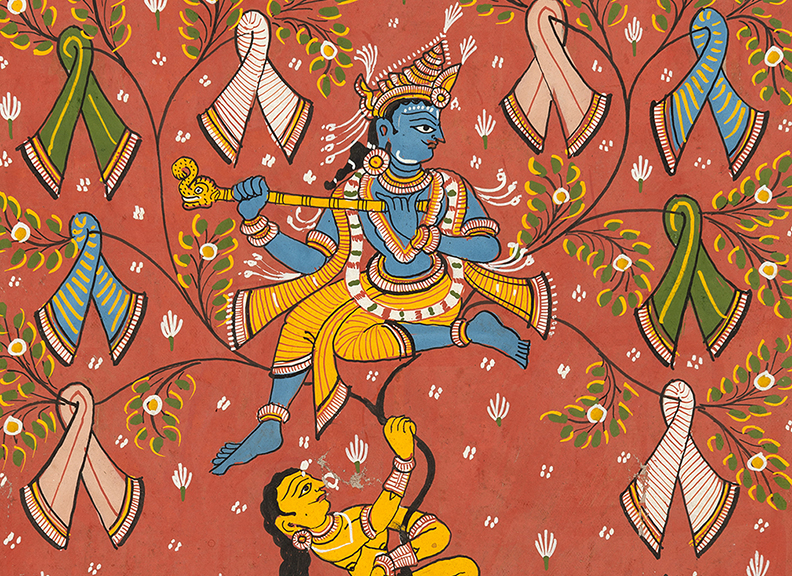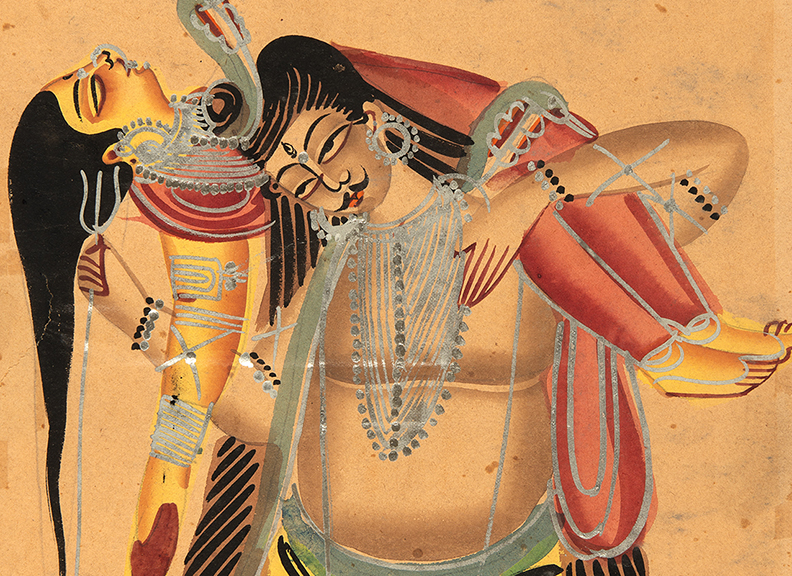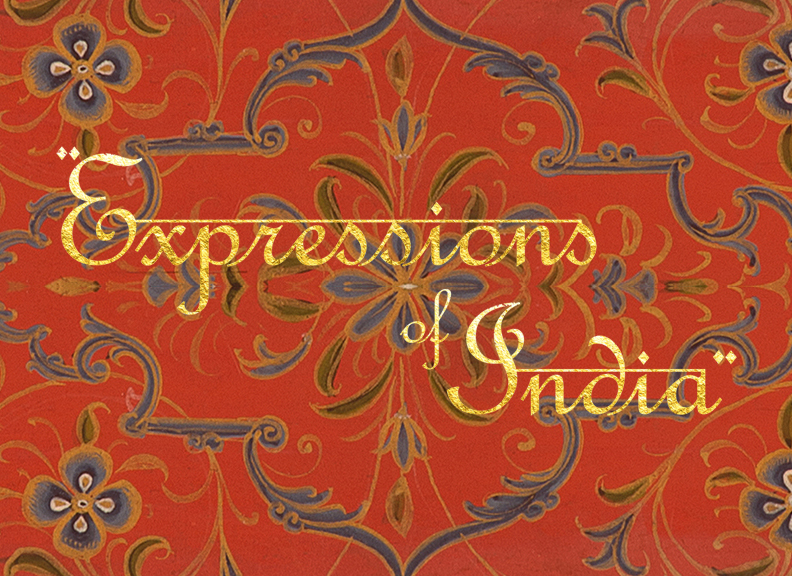The court paintings of eighteenth and nineteenth century India epitomise the cultural and political amalgam that began formation within the region almost five centuries prior. Muslim forces invading from the west at the end of the twelfth century conquered and established themselves across the majority of the Indian subcontinent. These Sultanates reigned for over 300 years until another Muslim dynasty, the Mughal Empire originating out of Central Asia, swept down across the subcontinent and supplanted them. Beleaguered, both militarily and socio-politically, first by the Sultanates and then by the Mughal Empire, the Rajput kingdom states of North-West India managed to cling to their Hindu beliefs and traditions as well as many elements of their administrative independence. Hostilities persisted until the start of the seventeenth century when, one by one, the Hindu rulers accepted the sovereignty of the Mughal emperor Akbar in trade for positions within his court, conditional control over their individual territories and the preservation of their faith. Allowed to flow more freely, it was at this point in time that cultural transference between the Mughal and Hindu states began to reach its height. Visits of tribute, residencies of tutelage and other forms of interaction between the Hindu nobility and the Mughal court helped catalyse this process. The Mughal Empire brought with them all the fineries of their sophisticated and opulent court culture, in particular, the styles and traditions of Persian court painting. Notable examples of this being the use of a cool palette, perspectival recession and identifiable portraiture. More readily exposed and accustomed to the refined and lavish offerings of Mughal court life, the Hindu nobility were quick to recognise the value of such cultural riches in demonstrating their stature and authority. They began sponsoring painters from their courts to learn the Persian styles and techniques, as well as commissioning Mughal court painters. These artists would produce for them their own portraits of important identities, scenes of court and palace life as well as images of Hindu religious narratives. Dependent upon the level of Mughal influence in each territory, it was not long before distinct regional styles of painting developed with variable degrees of blending of Mughal and classical Indian painting practice.
The court paintings included as part of the R.M. and C.H. Berndt Bequest Collection were sought and collated by Ronald and Catherine over a span of years from a variety of secondary market sources around the world. These delicately detailed watercolour paintings utilising opaque paints on quality paper explore scenes of everyday palace life, examine the complexities of courtship and matters of the heart, as well as illustrate poetry, folk-tales, Hindu epics and scripture. The inclusion of secular themes in these paintings sets them apart from the other collections included in the exhibition, reflecting the social circumstance of those commissioning and accessing these works. Paintings such as these were traditionally utilised within a folio through which nobles would peruse and discuss amongst themselves or reflect upon during moments of solitude.
Rama and Lakshmana Battle Ravana
Rama and Lakshmana Battle Ravana
19th century. Jaipur, Rajasthan, India. Opaque watercolour on paper, 28.4 x 20.2 cm. Bequest of RM & CH Berndt, Berndt Museum of Anthropology Collection [1994/0868]
This painting depicts the climactic final battle in the Yuddha/Langka Kanda – the penultimate episode of the Ramayana. This episode details the efforts of Rama (seventh avatar of Vishnu), with his brother Lakshmana and devoted monkey-general Hanuman, to rescue Rama’s wife Sita from Ravana, the demon-king. This encounter takes place on Langka (Sri Lanka), Ravana’s island stronghold. Rama and Lakshmana can be seen on the left wielding bows, Rama identifiable by his characteristic blue skin. Hanuman appears to grapple with Ravana’s demon-general towards the bottom of the scene. A walled stronghold sits in the top right corner, where Sita is being held captive. The ten headed, twenty armed Ravana is depicted finally defeated by Rama, an arrow through his chest. It is told that the shot was so powerful, the arrow passed through the demon-king and circled the earth unhindered, finally coming to rest back in Rama’s quiver.
Women through a Window
Women through a Window
19th century. Jodhpur, Rajasthan, India. Opaque watercolour and gold on paper, 30.2 x 24.2 cm. Bequest of RM & CH Berndt, Berndt Museum of Anthropology [1994/0869]
This painting portrays two women sharing each other’s company as they pass a window – perhaps one of the few glimpses an outsider might gain into the zenana, the secluded inner sanctum reserved for the women of the upper classes. The painting appears to have been composed in a manner that emphasises the significance of this sighting. The drawn curtain, window frame, dark space and shallow shading around the figures are all evocative of a stage scene playing out, with the two women in the spotlight. They stand, likely not knowing they are on display with gold hemmed diaphanous shawls and veritably bejewelled with pearls, rubies and more gold. The two women huddle closely, deep in each other’s confidence, accentuated by the absence of any shading between them in contrast with the dark background. The intrigues they whisper to each other remain yet another mystery of the zenana.
A Lady at her Toilette with Attendant
A Lady at her Toilette with Attendant
19th century. Jodhpur, Rajasthan, India. Opaque watercolour and gold on paper, 22 x 13.5 cm. Bequest of RM & CH Berndt, Berndt Museum of Anthropology [1994/0870]
This painting depicts a glimpse into the zenana – the women’s sanctum within the various Maharaja and Maharana palaces across the Indian subcontinent. The zenana is where the women of the ruling family and the king’s concubines lived in seclusion with various female attendants and entertainers. Typically, access to this sanctum was restricted to the ruler and a select few attendants. As such, most depictions of this subject are idealised imaginings by the artist, emphasising the poise, beauty and virtue of the court ladies - with the occasional soupçon of titillation and intrigue added into the mix.
The towering wall of the background denotes the seclusion of the zenana and elicits a sense of intrusion into a forbidden scene. The voyeuristic undertones of the image are compounded by the presence of the white crane in the bottom right corner. The crane is often symbolic of conjugal loyalty and devotion and in this instance could be purported to safeguard the ladies virtue. The viewer watches her, but perhaps it was not her intent to be viewed.
Proşitapatika Nayika – A Lady Whose Beloved is Absent
Proşitapatika Nayika – A Lady Whose Beloved is Absent
19th century. Jaipur, Rajasthan, India. Opaque watercolour and gold on paper, 30 x 21.5 cm. Bequest of RM & CH Berndt, Berndt Museum of Anthropology [1994/0871]
This paintings portrays Proşitapatika Nayika (a lady whose beloved is absent), which is one of the eight illustrations of dramatic personae known as Ashta-Nayika. These representations examine the archetypal emotional states of a female protagonist regarding her relationship with a man.
The lady sits on a terrace at night accompanied by her confidant. Night scenes are typically related to affairs of the heart, whether a tryst between two lovers, the pining of separated lovers or the anguish of heartbreak. The young lady sits on a cushion strewn rug, cup loosely held in hand, eyes closed and head bowed in despondency. She has been parted from a lover and her sorrow has been amplified by drink and the ominous gloom of the night. Her confidant kneels next to her in a pose of consolation, tending to their cups as needed.
Nobleman and a Lady
Nobleman and a Lady
19th century. Jaipur, Rajasthan, India. Opaque watercolour and gold on paper, 31.3 x 21.7 cm. Bequest of RM & CH Berndt, Berndt Museum of Anthropology [1994/0872]
This painting depicts a night-time tryst between a young couple who sit on an open-air terrace beneath the stars. The nobleman pours and proffers a cup to the lady, who has looked away coyly, partially covering her face with her veil. She sits close, her knees facing his, perhaps suggesting she is not dismissive of his attentions, but rather, caught in a moment of self-consciousness.
Depictions exploring everyday concerns of the heart were a common theme for Indian miniature paintings. Much as they do in the present, through a myriad of mediums, examinations of these particular human interactions provided a source of intrigue and entertainment for those of means.
Unknown Rupkatha (Folk-tale)
Unknown Rupkatha (Folk-tale) Scene
19th century. Jaipur, Rajasthan, India. Opaque watercolour and gold on paper, 29 x 21.2 cm. Bequest of RM & CH Berndt, Berndt Museum of Anthropology [1994/0873]
This painting likely depicts a scene from an Indian folk or fairy tale. These stories were typically parables with a moral and aided in guiding social values. Three demons are depicted in the courtyard, the inclusion of such mythical beasts were common in these kind of tales and typically personified undesirable or unacceptable social behaviour and vice.
Abhisarika Nayika (one going to meet her lover) and the Conflicted Confidant
Abhisarika Nayika (one going to meet her lover) and the Conflicted Confidant
19th century. Jaipur, Rajasthan, India. Opaque watercolour and gold on paper, 31.7 x 21.6 cm. Bequest of RM & CH Berndt, Berndt Museum of Anthropology [1994/0874]
This paintings portrays Abhisarika Nayika (one going to meet her lover), which is one of the eight illustrations of dramatic personae known as Ashta-Nayika. These representations examine the archetypal emotional states of a female protagonist regarding her relationship with a man.
This painting portrays two women on a terrace walkway; one in a resplendent sheer gold outfit accentuated with red and gold slippers; the other in a more modest floral skirt with orange shawl and bare feet. The lady in gold appears to be captured in motion, determinedly striding towards the edge of the scene. She looks back at her confidant, who has her grasped by the arm, impeding her progress. The confidant has her free hand to her mouth in a gesture of conflicted thought. She appears unsure whether or not she should dissuade her companion from her current course, or she is having second thoughts about what they are undertaking together. The lady in gold has dressed herself to impress and is intent to meet a suitor perhaps considered to be less than suitable.
Portrait of a King Riding a Composite Horse
Portrait of a King Riding a Composite Horse
Late 18th century. Jaipur, Rajasthan, India. Opaque watercolour and gold on paper, 38.2 x 30.5 cm. Bequest of RM & CH Berndt, Berndt Museum of Anthropology [1994/0904]
This painting depicts a Maharana (King) – distinguishable by the nimbus of gold around his head, which indicates his divine ancestry. Treatment such as this was reserved solely for portrayals of kings and the avatars of gods. The general composition of the work is typical of equestrian portraiture of distinguished identities from the Indian courts – the shallow foreground; the rich malachite (green) background; the dramatic ribbon of clouded sky across the top; and horse and rider in motion. What is most unique about this painting is that the young Maharana looks straight out at the viewer, as if in acknowledgement of our presence. Archetypally, the subject was depicted in profile, looking forward, chin slightly raised, and an air of indifference towards his surrounds. This distinctive characteristic, in conjunction with the fantastic puzzle-like composite animal steed, suggest a more playful approach by the artist and could be said to lend greater weight to the majesty of the subjects portrayal. It is probable that this may in fact be, or is a derivative of, a depiction of King Solomon, who was often referred to as the ‘lord of all animals’ and thought to be able to speak to and command them.
Rama, Sita and Lakshmana in Exile Visited by Shurpanakha - Sister of Ravana
Rama, Sita and Lakshmana in Exile Visited by Shurpanakha - Sister of Ravana
18th century. Jaipur, Rajasthan, India. Opaque watercolour and gold on paper, 27.7 x 39.5 cm. Bequest of RM & CH Berndt, Berndt Museum of Anthropology Collection [1994/0906]
Through a series of sequential panels, this painting details a significant moment in the Aranya Kanda (third episode of the Ramayana). After being exiled by his father King Dasharatha, Rama (seventh avatar of Vishnu) characteristically depicted with blue skin, joined by his wife Sita and brother Lakshmana, built cottages on the Godavari River within the Panchavati Forest. It is here they encounter a rakshasi (demoness) named Shurpanakha - sister of Ravana the demon-king. Shurpanakha quickly becomes infatuated with Rama, who gently rebuffs her advances, stating his unyielding fidelity to his wife Sita. The rakshasi then turns her amorous attentions to Lakshmana, who indelicately informs Shurpanakha that she is not what he desires for his wife. Enraged by humiliation and envy, the demoness attempts to attack Sita but is thwarted by the ever-vigilant Lakshmana, who proceeds to cut off her nose and ear as punishment and sends her on her way back to her brother’s island stronghold (Sri Lanka).
It is these events in the Ramayana that leads to the eventual abduction of Sita by Ravana, Shurpanakha’s brother. The culminating battle to rescue Sita is depicted in the painting Rama and Lakshmana Battle Ravana, also included in the exhibition.
Krishna and Radha on Nari Kunjara - Composite Elephant Made of Gopis (Milkmaids)
Krishna and Radha on Nari Kunjara - Composite Elephant Made of Gopis (Milkmaids)
19th century. Jaipur, Rajasthan, India. Opaque watercolour and gold on paper, 31.6 x 25.6 cm. Bequest of RM & CH Berndt, Berndt Museum of Anthropology [1994/0907]
Krishna, the eighth avatar of Vishnu, was born to Devaki and her husband Vasudeva. Devaki was sister to the tyrannical ruler of the Vrishni kingdom, Kansa, who was foretold the prophecy of his death at the hands of his sister’s eighth son. To save Krishna from the wrath of Kansa on the day of his birth, Vasudeva carries the infant across the Yamuna River to a nearby cow herder’s home and exchanges his son for another newborn. Krishna is raised by Nanda and his wife Yashoda amongst the Yadava tribe, where he steals butter as a child and the hearts of gopis (milkmaids) as an adolescent. He creates a flute from the bamboo growing along the banks of the Yamuna and enchants the gopis into song, dance and revelry with his music. Among the gopis he meets his beloved, the beautiful and compassionate Radha; their connection epitomising love-eternal.
This painting depicts the classic and celebrated portrayal of adolescent Krishna playing the flute; his cherished Radha by his side; and a group of enchanted gopis around them. The composite elephant formation taken by the gopis puts a more playful twist on the classical scene and is likely emblematic of Krishna’s power and eminence.
The Month of Asarh (June – July)
The Month of Asarh (June – July)
19th century. Uniare, Rajasthan, India. Opaque watercolour and Gold on paper, 29 x 21.2 cm. Bequest of RM & CH Berndt, Berndt Museum of Anthropology [1994/0908]
This painting is an illustration to a Barahmasa (barah, twelve; masa, month) – a Hindu poem describing love, longing and other matters of the heart in relation to, and set within, a specific month, with the intent of evoking a particular mood. In this instance the month of Asarh (June – July) is explored. Asarh is in the midst of the monsoon season in India and this is particularly apparent in the depiction – the background rises and darkens into a tumultuous maelstrom while a golden ribbon of lightning serpentines through the clouds; a strong wind seems to blow from right to left bowing the trees; the river’s waters are high and the plants on its bank appear to writhe and whirl. This time of the year was typically associated in Hindu poetry with the longing of separated lovers, and so a lonely maiden is portrayed wandering through a garden against the onslaught of her environs. She appears to glance upwards towards a pavilion where the idyllic lovers Krishna and Radha share an amorous moment together – ever the symbols of enduring love and devotion. In the top left corner, two princes consult a hermit before embarking on a journey, perhaps one is the object of the young maiden’s longing. Nestled within a bower on the bank of the river is a small shrine with Lingam and Nandi (the bull) – symbolic associations to the god Shiva. Below the shrine, reflected in the surface of the water, is the image of a tiny golden pavilion in which Krishna and Radha lie in passionate embrace – perhaps a playful and titillating insight into the outcome of their tryst on the part of the artist.
Devi Mahatmyam - Durga Receiving the Homage of the Devas
Devi Mahatmyam - Durga Receiving the Homage of the Devas
Late 18th century. Jaipur, Rajasthan, India. Opaque watercolour and Gold on paper, 30.4 x 40.7 cm. Bequest of RM & CH Berndt, Berndt Museum of Anthropology [1994/0909]
This painting depicts a scene from the Devi Mahatmyam, which details the story of the goddess incarnation Durga being called upon to battle and defeat the demon Mahishasura, who has conquered the heavens, and whom no man can kill. In this scene Durga sits upon a raised platform next to her masculine counterpart Shiva. The other deities or Devas have gathered before them, each bequeathing Durga with a weapon, armour or boon emblematic of their power. She holds this myriad of armaments in her many outstretched hands, now fully equipped for the battle to come. Himavat, lord of the mountains gifts the goddess with a lion mount, the head of which is depicted behind the stone outcrop in the foreground. Nandi the cow, Shiva’s symbolic companion and mount also makes an appearance in the bottom right corner of the painting, highlighting further the deity’s prominence in this particular portrayal.



